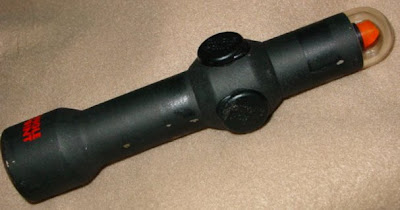A Rifleman Went To War, by H.W. McBride
I'm starting today to review some notable books on guns and shooting. First up is Herbert McBride's A Rifleman Went to War
As a memoir it is not very good. It is repetitious, filled with digressions and in places pursues minor points at great length. Read another way, though, the book is a gold mine. It is filled with insights about sniping and combat shooting that can occur in only one way: You put an expert shot into the thick of war and see how things turn out. What works? What doesn't? Here are insights on marksmanship and weapons, and on training versus reality, that can arise in no other way.
Something sure to be of professional interest today: McBride, all those years ago, distinguished the difference between sniping from hidden positions, in fairly static situations, and the work of an expert rifleman accompanying advancing troops. Today we would call this the distinction between sniper and Designated Marksman. The skills overlap but the roles are different. McBride devotes a chapter to each job and his conclusions are not far off from the latest in military doctrine. One thing that could use more attention today is McBride's contention that the DM's rifle should be as short and handy as it can be made, consistent with what it needs to do.
The sniper's rifle McBride used was the Ross with a Warner & Swasey scope. Some of his conclusions about rifles and sights are still quite relevant, though we are now many years on in the development of both.
McBride approved very much of the scope mount he was issued, which mounted the scope offset to the left side of the rifle. It let him use his iron sights if he liked, and to check the scope against the irons. As to the theoretical problem with this setup (an additional axis of parallax), he dismissed it, saying he couldn't hold close enough for that to make a difference, anyway.
Did progress proceed in the wrong direction, here? Scopes are nowadays mounted over the bore. While scopes are more reliable than in McBride's day, and we are less likely to need the iron sights for the reason the scope has broken or gone cockeyed, there are still situations in which the irons are of more use. McBride writes,
You cannot work a telescope in the rain with any degree of satisfaction, and even a light fog or mist will cloud up the lens continually. The rifle cannot be carried through wet or dew-covered underbrush without throwing water all over the lens. Even taking the rifle from a comparatively "warm" dugout out into the open air may fog up the lens so badly you cannot see through them. And finally there is the dirt and the mud to be considered, and the wiping of a few specks of mud or grit from a telescope is a job to be gone about with much caution--and a soft clean rag, else you will soon ruin the glass from scratches.Though some modern lens coatings and treatments claim to alleviate some or other of these problems to an extent, it is plain the same problems are still with us.
Something that may seem a bit odd to modern readers: McBride enjoyed his work as a rifleman and was quietly proud of his kills. In this oh-so-sensitive age of PC, that might not get by a publisher's editorial board. McBride has his own voice and comes across as thoughtful, but a no-nonsense customer. He dismisses "sob stuff," such as the movie All Quiet On The Western Front, saying it wasn't like that at all. Soldiers, in his experience, tended to be stoical and matter-of-fact. He generally was, as when, in Flanders, he shot a man who--apparently, anyway--had just shot a Canadian soldier. But the shooter was wearing civilian clothes, not a uniform.
I did not have time to do much thinking but simply acted on impulse. Taking deliberate aim, I shot him through the middle and he dropped.
Then I commenced to feel a little bit shaky. Down in my heart, I knew that I was right but the whole thing came up so quickly and was so queer all around that, for a few moments, I was at a loss as to what to do. . . . We found the fellow dead, of course. He was dressed in the usual costume of the farmers thereabouts and had not a single thing on his person but his clothing. . . . we just rolled the body over under the hedge and left it there, together with the rifle. From that day to this I have never mentioned that affair to anyone.
The book is a large assortment of insights and reflections, terribly disorganized but valuable all the same, on sniping and spotting, combat shooting with rifle and pistol, patrolling at night, the use of machineguns, and on military administration and policies, and the nature of the face of war. It also contains cameo accounts of strange or amusing episodes on and behind the lines. It is, taken all together, a fascinating look at combat skills, martial mindset and human reactions to war. If you can put up with McBride's scrambled-up way of telling things, you will learn a lot.
-----------
Addendum: You can read a fascinating biography of McBride here. Among other things, it may explain the eccentricities of his writing style.


Comments
Post a Comment